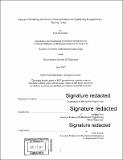| dc.contributor.advisor | Sangbae Kim. | en_US |
| dc.contributor.author | Studebaker, Seth | en_US |
| dc.contributor.other | Massachusetts Institute of Technology. Department of Mechanical Engineering. | en_US |
| dc.date.accessioned | 2017-12-05T19:17:32Z | |
| dc.date.available | 2017-12-05T19:17:32Z | |
| dc.date.copyright | 2017 | en_US |
| dc.date.issued | 2017 | en_US |
| dc.identifier.uri | http://hdl.handle.net/1721.1/112542 | |
| dc.description | Thesis: S.B., Massachusetts Institute of Technology, Department of Mechanical Engineering, 2017. | en_US |
| dc.description | Cataloged from PDF version of thesis. | en_US |
| dc.description | Includes bibliographical references (page 54). | en_US |
| dc.description.abstract | with the ultimate goal of assisting the elderly and disabled with fall prevention and mitigation as well as providing athletes with critical data for training. The force sensing footpad, originally developed for use on the MIT Cheetah robot, integrates lightweight pressure sensors and a urethane rubber, Smooth-On's Vytaflex@ 20, to sense force in both the normal and shear directions. In previous work, cylindrical footpads with a single pressure sensor of differing heights and diameters were tested by applying displacements to the material. The experimental force and voltage from the pressure sensor were recorded. The thesis aims to provide a Finite Element Analysis (FEA) model in Abaqus that accurately simulates and models the footpad sensors and is validated by the physical experimental results. While previous work had been done to model and simulate the footpad using FEA, little was known about the properties of the Vytaflex@ material and a Neo-Hookean model based on coefficients for a silicone rubber was used to model the footpad. In order to provide accurate simulations, the thesis seeks to determine the best hyperelastic constitutive model to describe the material. Uniaxial tensile, uniaxial compression, planar tension, and volumetric compression tests were performed to determine the hyperelastic material model of the rubber. The Odgen n=2 material model was determined to be the best fit for the data and was used to describe the material properties in the Abaqus simulations. Abaqus models were created to represent the various cylindrical footpads and simulations were run using Abaqus's dynamic explicit analysis. Stress data from the simulation results was then converted to a voltage using an effective sensitivity and intercept adjustment factor. The effective sensitivity and intercept adjustment factor were adjusted until the simulation results matched that of the experiments. Using these constants, the stresses inside the footpad can now be determined from the voltage readings of the pressure sensor. | en_US |
| dc.description.statementofresponsibility | by Seth Studebaker. | en_US |
| dc.format.extent | 54 pages | en_US |
| dc.language.iso | eng | en_US |
| dc.publisher | Massachusetts Institute of Technology | en_US |
| dc.rights | MIT theses are protected by copyright. They may be viewed, downloaded, or printed from this source but further reproduction or distribution in any format is prohibited without written permission. | en_US |
| dc.rights.uri | http://dspace.mit.edu/handle/1721.1/7582 | en_US |
| dc.subject | Mechanical Engineering. | en_US |
| dc.title | Material modeling and sensor characterization for optimizing footpad force sensing array | en_US |
| dc.type | Thesis | en_US |
| dc.description.degree | S.B. | en_US |
| dc.contributor.department | Massachusetts Institute of Technology. Department of Mechanical Engineering | |
| dc.identifier.oclc | 1012944434 | en_US |
